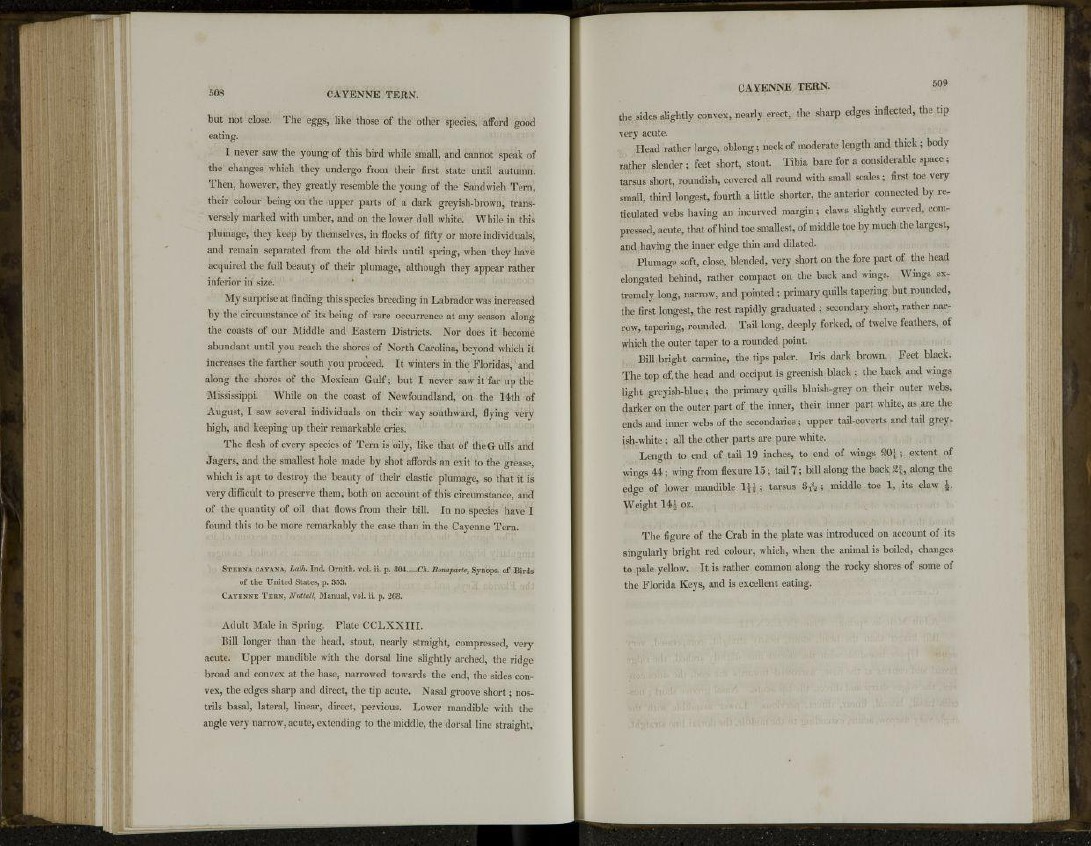
508 CAYENNE TERN.
but not close. The eggs, like those of the other species, afford good
eating.
I never saw the young of this bird while small, and cannot speak of
the changes which they undergo from their first state until autumn.
Then, however, they greatly resemble the young of the Sandwich Tern,
their colour being on the upper parts of a dark greyish-brown, transversely
marked with umber, and on the lower dull white. While in this
plumage, they keep by themselves, in flocks of fifty or more individuals,
and remain separated from the old birds until spring, when they have
acquired the full beauty of their plumage, although they appear rather
inferior in size.
My surprise at finding this species breeding in Labrador was increased
by the circumstance of its being of rare occurrence at any season along
the coasts of our Middle and Eastern Districts. Nor does it become
abundant until you reach the shores of North Carolina, beyond which it
increases the farther south you proceed. It winters in the Floridas, and
along the shores of the Mexican Gulf; but I never saw it far up the
Mississippi. While on the coast of Newfoundland, on the 14th of
August, I saw several individuals on their way southward, flying very
high, and keeping up their remarkable cries.
The flesh of every species of Tern is oily, like that of theG ulls and
Jagers, and the smallest hole made by shot affords an exit to the grease,
which is apt to destroy the beauty of their elastic plumage, so that it is
very difficult to preserve them, both on account of this circumstance, and
of the quantity of oil that flows from their bill. In no species have I
found this to be more remarkably the case than in the Cayenne Tern.
STERNA CAYANA, Lath. Ind. Ornith. vol. ii. p. 804—Ch. Bonaparte, Synops. of Birds
of the United States, p. 353.
CAYENNE TERN, Nuttall, Manual, vol. ii. p. 268.
Adult Male in Spring. Plate CCLXXIII.
Bill longer than the head, stout, nearly straight, compressed, very
acute. Upper mandible with the dorsal line slightly arched, the ridge
broad and convex at the base, narrowed towards the end, the sides convex,
the edges sharp and direct, the tip acute. Nasal groove short; nostrils
basal, lateral, linear, direct, pervious. Lower mandible with the
angle very narrow, acute, extending to the middle, the dorsal line straight,
CAYENNE TERN. 509
the sides slightly convex, nearly erect, the sharp edges inflected, the tip
very acute.
Head rather large, oblong ; neck of moderate length and thick; body
rather slender ; feet short, stout. Tibia bare for a considerable space ;
tarsus short, roundish, covered all round with small scales; first toe very
small, third longest, fourth a little shorter, the anterior connected by reticulated
webs having an incurved margin; claws slightly curved, compressed,
acute, that of hind toe smallest, of middle toe by much the largest,
and having the inner edge thin and dilated.
Plumage soft, close, blended, very short on the fore part of the head
elongated behind, rather compact on the back and wings. Wings extremely
long, narrow, and pointed ; primary quills tapering but rounded,
the first longest, the rest rapidly graduated ; secondary short, rather narrow,
tapering, rounded. Tail long, deeply forked, of twelve feathers, of
which the outer taper to a rounded point.
Bill bright carmine, the tips paler. Iris dark brown. Feet black.
The top of, the head and occiput is greenish black ; the back and wings
light greyish-blue; the primary quills bluish-grey on their outer webs,
darker on the outer part of the inner, their inner part white, as are the
ends and inner webs of the secondaries; upper tail-coverts and tail greyish
white ; all the other parts are pure white.
Length to end of tail 19 inches, to end of wings 2 0 | ; extent of
wings 44; wing from flexure 15; tail 7; bill along the back 2^, along the
edge of lower mandible \ \ \ \ tarsus 3i2g ; middle toe 1, its claw
Weight 14 £ oz.
The figure of the Crab in the plate was introduced on account of its
singularly bright red colour, which, when the animal is boiled, changes
to pale yellow. It is rather common along the rocky shores of some of
the Florida Keys, and is excellent eating.